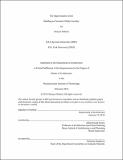The opportunistic green : building on Toronto's utility corridor
Author(s)
Rahimi, Kamyar
DownloadFull printable version (89.53Mb)
Other Contributors
Massachusetts Institute of Technology. Department of Architecture.
Advisor
Adèle Naudé Santos.
Terms of use
Metadata
Show full item recordAbstract
The Green Line or hydro corridors of Toronto are sprawling lengths of continuous, mostly vacant land used for the primary purpose of transmitting electricity. They are unusual terrain, physically sparse but culturally intense. Stippled with electrical towers, planned in acres of mowed grass, they hold the promise of light, energy and power. Within a 125 mile radius of downtown Toronto, there are approximately 8,145 acres of land passing through a wide range of neighborhoods and fabrics--yet they currently have very little to offer beyond the transmission of electricity. The stigma of living next to these high voltage power lines--with their aging infrastructure and the health hazards associated with the hydro towers--has resulted in a dearth of development along these corridors. This thesis investigates the opportunities created by reclaiming one of these public corridors, which is currently an underutilized urban void. The decision to bury the high voltage power lines underground creates a space for economic and social opportunities. The new programs promote potential for social and economic growth and come together in a unique narrow and linear site condition. As an urban strategy that brings together domestic culture with infrastructure and manufacturing, this project can create a radical and innovative urban fabric. By introducing a new underground transportation line and densifying the area around the stops, the new urban fabric could be organized as a sequence of urban centers, while promoting the preservation of the remaining green corridor. The opportunistic corridor will be a series of high density to low density spaces coupled with manufacturing hubs that ultimately add cultural and real estate value to the surrounding neighborhoods. Consequently, one of the most profane areas of the city, associated with chronic toxicity, could be transformed into one of its most desirable neighborhoods.
Description
Thesis: M. Arch., Massachusetts Institute of Technology, Department of Architecture, 2014. This electronic version was submitted by the student author. The certified thesis is available in the Institute Archives and Special Collections. Cataloged from student-submitted PDF version of thesis. Includes bibliographical references (pages 98-99).
Date issued
2014Department
Massachusetts Institute of Technology. Department of ArchitecturePublisher
Massachusetts Institute of Technology
Keywords
Architecture.